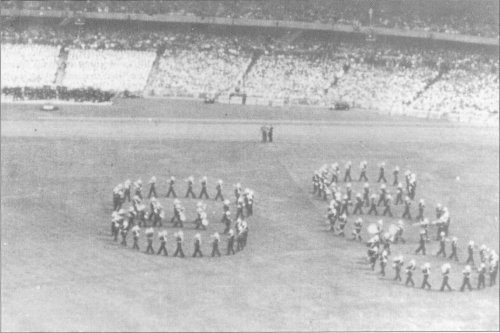- Author
- William F. Cook, MVO, Captain, RAN (Rtd)
- Subjects
- History - general
- Tags
-
- RAN Ships
- HMAS Swan II, HMAS Warramunga I, HMAS Sprightly
- Publication
- September 2000 edition of the Naval Historical Review (all rights reserved)
The Closing Ceremony was even more remarkable. Frankly, I expected it to be an anti-climax. The contests were over. The last stopwatch had been put away. True, there was a great choir which sang unforgettably. There was a sort of retrospective hubbub in the crowd. But there was no organised march of teams. On the contrary, they all got mingled together. They marched around the ground, very badly from the point of view of a drill sergeant, dressed in all sorts and conditions of garments, chatting to each other, waving to their friends, new or old. You would have thought that nothing much could come of such a march. But it was in fact superbly dramatic.
On the first day they had all marched as competitors in their national teams, preserving their national identity, headed by their national flags. On the last day they went around the arena as men and women who had learned to be friends, who had broken down some of the barriers of language, of strangeness, of private prejudices.
And because of this, the last day became a remarkable international demonstration, carrying with it a significance which was not overlooked by anybody lucky enough to be present.
Robert G. Menzies President of the Games
Further excerpts from the Official Report are of interest to us: –
SERVICES PARTICIPATION
The Armed Services of the Commonwealth of Australia gave valuable assistance to the Organising Committee, not only in the Opening and Closing Ceremonies and on other formal occasions, but also in the conduct of the competitions and in training, housing and other activities.
Navy
The Royal Australian Navy, South-East Australian Area, provided manpower for:
- Street lining during the progress of the Duke of Edinburgh
- Guards of honour
- Marshals, usherettes and messenger service at venues
- Electronics technical personnel
- Bands for ceremonial occasions
- Sick-bay attendants at venues
The Navy was responsible also for certain services, mostly of a specialist character. It evolved, produced and laid marker buoys for the yachting courses. It produced a chart for yachting competitors. It provided three ships (H.M.A.Ships Warramunga, Swan and Sprightly) to act as starter vessels and to accommodate the Judges, established and manned a radio communication centre at yachting headquarters and manned smoke float launches and control boats on the courses. The Navy also provided sentries and general assistance at Yacht Clubs, and stored the Finn monotypes as received from the builders until their distribution to competitors.
A total of 1,009 officers and men was employed.

The musical programme at the Opening Ceremony consisted firstly of a display of marching by the band of the Royal Australian Navy which, on the arrival of His Royal Highness the Duke of Edinburgh, combined with the massed bands of the Australian Army under the baton of Major A.R. Newman, Army Director of Music, to play the National Anthem. There then followed a display by the massed bands of the Australian Army representing all Commands, and numbering 220 players. One formation in the display which won special applause was the presentation of simultaneous marching and playing which resolved into a design of the five interlocking rings of the Olympic symbol.
The last excerpt could be ambiguous. The photo clearly shows that it was the RAN Band alone which, while marching, resolved itself into a design of the five interlocking rings of the Olympic symbol. Perhaps the uniforms of the Navy bandsmen still in the style of their predecessors, the Royal Marines, led to the unfortunate mistake.




